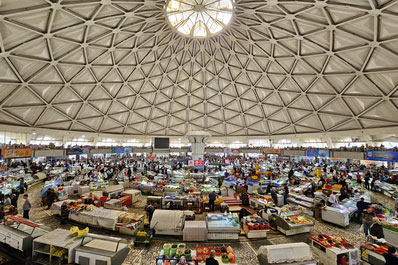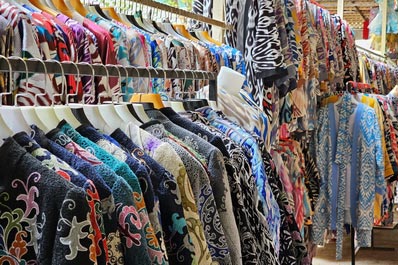Chorsu Bazaar, Tashkent

Chorsu Bazaar is the largest market in Central Asia, once a bustling hub on the Great Silk Road. "Chorsu" translates to "crossroads of four roads", perfectly describing its historic role. Caravan routes from the east to west and north to south converged here, creating a lively center filled with hundreds of stalls, inns, and travelers from around the globe.
Back in medieval times, Chorsu Bazaar was a vibrant marketplace. Imagine caravans loaded with goods arriving from the hot desert, camels and horses finally drinking water, and merchants resting in the cool caravanserais. Merchants displayed exotic goods, fabrics, and much more in the narrow, bustling rows of food stalls. The air was filled with the shouts of vendors and the delightful smells of spices, tobacco, tea, and fresh fruit. It was a dynamic dance of colors, patterns, textures, and sounds that symbolized the essence of life.
Today, you won't see camels or ancient trading shops at Chorsu Bazaar. However, it has managed to retain the authentic atmosphere of an oriental bazaar. Here, you can still buy juicy Uzbek fruits, nuts, sweets, and other delicious treats.
Modern Bazaar Building
The Chorsu Bazaar, with its iconic seven domes, was built in the 1970s during a period of bold architectural projects in Tashkent, the capital of Uzbekistan. After the devastating earthquake in 1966, Tashkent underwent urgent reconstruction. This period led to what researchers now call "seismic modernism", resulting in a mass of futuristic buildings. Today, Chorsu Bazaar stands as a legendary example of Soviet architecture, a distinctive feature of the old city.
Architecture and Structure
The heart of Chorsu Bazaar is a massive dome covering a spacious two-floor trading hall. The dome rests on concrete pillars connected by panoramic glass arches, and its exterior is adorned with blue and green mosaic patterns reminiscent of traditional designs. The structure resembles a giant tent, buzzing with trade. The bazaar has four entrances facing different directions, and additional pavilions offer a wide range of goods.
The first floor of the bazaar features meat, dairy products, homemade cheeses, vegetables, and fruits. You can find unique items like horse heart or horse fat. The upper level is dedicated to nuts, dried fruits, teas, and spices. The covered shopping rows next to the main "tent" sell vegetables, herbs, fruits, flatbreads, and traditional sweets.
Before visiting Chorsu Bazaar, be prepared for sellers eagerly offering samples of their goods. Tasting products here is a special experience! The vendors are friendly and engaging, making it hard to resist a juicy peach or fragrant melon. It's best to explore Chorsu on an empty stomach. Near the main pavilions, you'll find a row of smoky kebabs, aromatic pilaf, rich lagman, and other Uzbek dishes. This area is affectionately known as "gluttony row" for its incredible array of tasty foods.
After a hearty meal, be sure to check out the array of souvenirs at Chorsu Bazaar. You'll find everything from small trinkets and elegant decorative bowls to painted vases and luxurious carpets woven by the skilled hands of Tashkent craftsmen. Tourists will love exploring the Uzbek national costumes, musical instruments, colorful dishware, carved woodwork, bags, belts, purses, leather goods, and traditional Uzbek dolls in national attire. Plan to spend at least half a day here; there’s so much to see and admire.
The area around the main pavilions is packed with stalls selling clothes, shoes, and even local barbershops where you can get a haircut.
Chorsu Bazaar is like a city within a city—vibrant, colorful, and full of life. It's worth visiting not just for the fresh fruit and souvenirs, but to experience the very soul of Tashkent, an ancient city that once stood at the crossroads of the Great Silk Road.











